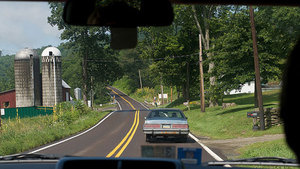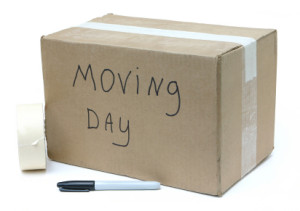Archive for the 'Moving with Kids' Category
By Relocation.com
When you sign a lease agreement, most likely you’ll be signing on for a set period of time, such as six months or one year. That means you’ll have to stay on for this amount of time or risk breaking your lease.
While many people do intend to stay long-term in their apartments or homes (after all, moving all the time can be costly) there are some unforeseen circumstances where you might be forced to break your lease before it us up, such as illness, job loss or other emergencies. If you absolutely have to break your lease agreement, here are some of the things you should consider.
Alternatives:
Before you try breaking your lease, there may be other things you can do first. You can ask your landlord if you can transfer the lease to someone you know (and have them move in and pay off the remaining rent for the lease term) or find a sub letter, who will be your responsibility for the time of the lease. In many cases, landlords hate breaking lease agreements because they don’t want to lose the income from the rent and/or don’t want to be bothered with having to look for tenants. If you make it as easy as possible for them, you may be able to get out of your lease unscathed.
Circumstances When You Can Legally Break Your Lease
There are three main circumstance wherein you can break your lease without penalty:
1) If the apartment or whom suffers serious damage through natural disasters, crime or other instances through no fault of your own.
2) If you suffer serious health issues which require you to live in an assisted living facility.
3) If you are called into active military duty after you’ve signed your lease
In these three cases, you can legally break the lease and your landlord cannot go after you for penalties.
Landlord Deficiencies:
If your landlord has been deficient in his or her duties, then you can also break your lease since he or she is not keeping up their end of the bargain. For example, if you’ve repeatedly sent requests for repairs and they ignore you, or if they’re supposed to pay for the utilities but haven’t (or have been keeping the payment for themselves if you give it to them) then you have just cause to break your lease. Make sure you keep good records (like written or e-mailed requests for repairs, etc.) so you can make your case, in the event that you have to go to small claims court or have been served with other legal documents and actions.
If you just want to break your lease because you want to move somewhere else, because you can’t pay or perhaps going through a divorce or separation, you may find it harder to break your lease. However, first talk to your landlord and offer the aforementioned alternatives, that way you can have a peace of mind when you coordinate other aspects of your move like locating moving companies.
By Relocation.com
If moving is hard for adults, it can even be harder for children. If you’re moving with your family, it is important that you make your children understand why you have to move and why they shouldn’t feel bad about it. The most common worries of children whether moving just across the town or moving to a ‘never-heard’ place are not being able to find new friends, getting bullied or set aside in their new school, not seeing their peers and not being comfortable with the entire place, new faces and all.
Books about Moving for Children
It is always best to inform your kids about the upcoming move as soon as possible. You need to give them time to think and allow themselves to accept it. One way to do this is to give them books about moving. There are books about moving for children that are written creatively. For sure, they would appreciate it. Other than having something to do while waiting for the moving day, they will also get the chance to understand the reason why you all have to move. Furthermore, you might not have all the time to oversee your kids during the day of move as you will be very busy looking after your belongings and making sure everything is ready. Giving them something to read can help ease their boredom and at the same time, can help them stay put.
Some Great Books about Moving for Kids:
I’m Not Moving, Mama
This is a story about a little mouse who refuses to leave his room on the very day of moving. You never can tell whether your kids are hundred percent ready to move even if you have told them about it weeks or months ahead. When the moving day comes, everything can get overwhelming for children that they end up doing tantrums, begging the entire family to just stay. This book can help your child cope with the anxiety that moving might bring.
Who Will Be My Friends?
As mentioned, one of the fears of children when confronted with the thought of moving is not being able to make new friends. This book is a story of a boy named Freddy and his journey to find new friends in the new neighborhood. It was hard in the end but eventually, Freddy was able to meet new friends and he was very happy.
We’re moving!
This story is about a little girl named Amy who has moved with her family. This book explains to children that getting comfortable in a new place takes time and effort but as days went by and new adventures come, everything will become normal as usual.
A Tiger Called Thomas
During the first days and nights in your new home, things can get very difficult for your child. The absence of friends and playmates can really make them feel alone and lonesome. Just like what Thomas felt on his moving story. But after a night of trick-or-treat, Thomas realized it’s not really that lonely being a new kid on the block.
There are more books about moving out there that your children will love. Encouraging them to read such kind of books will take away the negative feelings they have towards moving.

Pass the time when moving in a car with some of these creative activities
By Richard Farrell
Special to Relocation.com
Moving across the country in car is one way to save money. However, when you add kids into that mix you have to consider that they may get bored – especially when you will be driving for hours on end. Check out some of our creative solutions to make it easier to get to your new home when driving.
Planning the Trip:
- Once you have chosen your route, it is time to calculate how long you are going to be a passenger or driver in the car. Allow for unforeseen delays such as traffic backlogs and diversions along the way. Once you know your likely journey time you can plan around it better.
- Pack a cooler of healthy snacks and lunch options for your initial ride. Once you get on the road, plan to use drive-through food outlets along the way as this will save a lot of time. Keep a couple of trash bags handy for any garbage.
- Wear sensible clothing and shoes for the journey. Choose comfortable shoes and clothing that are easy to slip off so that you can relax and let your feet breathe. Long trips will likely result in posture issues and your feet will soon remind you of the fact that you are not comfortable. Shoelaces are not practical in these circumstances.
- Should you be sharing the driving, do make sure you stop in a safe place and take time out to walk about and do some breathing exercises before you take the wheel. Include some stretching exercises too..
- Consuming of alcoholic beverages immediately before or while traveling makes for another definite “no.” Apart from affecting your reaction time it is breaking the law and your journey to your new destination will be remembered for all the wrong reasons!
7 Fun Tips to Pass Time in a Car:
- Bring CD’s. Sort through your CD collection and pick out some favorites and maybe a couple that you have not played for some time.
- Radio. Satellite radio played through your car sound system is of excellent quality and clarity. Tune in to your favorite stations before you set off.
- Books and Magazines. Kids love books and magazines. Make sure you have plenty for the journey.
- Music DVD’s. You may be lucky enough to have a sophisticated in-car system. If not, then there are plenty of good quality portable players for you to enjoy the latest movie offerings as well.
- Take Naps. Short napping is good, but sleeping the entire journey may be considered antisocial, and besides you will be missing the passing scenery and could arrive feeling less than your best.
- Food. Choose snack food that does not make a big mess. Dry snacks such as chips and peanuts or glazed dry fruit are great for the car. Avoid too much intake of food and drink or you will be stopping at every restroom along the way.
- Rotate Drivers Regularly. This is very important for long journeys. If you are the only driver you will need to consider breaking your journey with an overnight stop. In any event, do stop every 90 minutes but make sure you pull over in a safe place.



Image Credit: Active Rain
By Relocation.com
There are several things to think about when changing schools for the kids. Starting with the educational offerings and then questioning the safety, affordability, transportation options and location. If you’re moving somewhere far (or at least far enough to change school districts), here are some issues you may think about when choosing a new school for your kids.
1. Security – Choose a school with great security features for the kids. Find out what they do to keep your kids safe from harm, and if there have been any other issues in the past.
2. Level of education – Schools always differ in levels of education. Although it may not be prominent, if you do a closer look at their alumni and their teachers to help you assess it.
3. Activities – Kids will mostly likely learn from activities faster than they do in classrooms. This has been scientifically proven. When they participate in events, they learn at higher rates. Activities also help develop confidence and will give boost to your child’s potential. Find a school with a good mix of activities – sports, arts, social clubs – so that they’ll have a wide range to choose from.
4. Transport and distance from home – Know that your kids may get stressed from long trips. Try to have a good proximity from your kid’s school. Kids often have the urge to stay close to home as much as possible, especially for toddlers.
5. Resources – if you are going to transfer your kid to another school, be sure to get him a new school with better resources. Better libraries, good classrooms, wider spaces – these matter to kids who are growing up and learning.
6. Cost – Finding a school that gives the best education that fits your budget may be challenge, but with research you’ll be able to do this. You can also find alternatives, like charter schools, or you can help your kids by augmenting their education with after-school programs or private tutors.
Changing schools for kids can be scary. Always try to consider their preference and try to put yourself in their position. When a kid changes schools most of the time he has to deal with the adversities of finding new friends and getting to know the place. This is what the kids are always thinking about, and perhaps not so much their education. Here are more tips on how to understand your kids’ feelings and help them move on to their new surroundings.
1. Friends – This is your kids’ priority. Try to encourage them to find new friends and get them out there to open up conversations. If your child is shy from the start, try to help them out by approaching other parents and introduce your child.
2. Bullies – for the first months, please do try to check on your kids. Bullies often target new comers, but will always be afraid of parents and teachers. Try to maintain a good presence.
3. Teachers – get to know their teachers and ask for feedback. Your kid is new and ask for everything that you need to know about the school.
4. A good playground – This is always good for younger kids. This is the best place for your kid to socialize and find a new circle of friends for him or herself

Moving with a teenager doesn't have to be difficult. Check out our tips for making this move easy!
By Dermound Becker
Special to Relocation.com
The stresses, strains, upheavals and turmoil of moving are difficult enough, but when you add teenagers to the mix, chances are things will be even more complicated. Not only do teenagers have raging hormones and pendulum-like mood swings, they generally, do not react well to change. When a family moves, they will have to leave everything that is safe and comfortable including their school, sports and other extramural activities and, most importantly, their friends. This could be a recipe for catastrophe, if it is not handled with a delicate hand and a lot of understanding.
The most important step to inform your family that you will be relocating to another area early on. Sit down with them and explain the reason for the move – whether it is for financial reasons or a new job. The main thing is to be honest and direct with your teens. Many teenagers feel that they are already adults and therefore need to be consulted on such a momentous decision; others will suddenly feel that they are not yet adults at all and will feel very vulnerable to the consequences of the move.
Throughout the process of planning, organizing and packing, take the time to listen to what your teenager has to say. Having a sympathetic ear may just be the lever needed in order to get him or her to get involved with the move, start sorting their possessions and maybe even begin packing a few boxes of their own. You may be surprised to learn that your teenager may even relish the thought of a move, if perhaps his or her current peer group is a bit boring and they actually need a change.
If at all possible, try to plan your move at the end of the school year, or at least at the end of a semester, as this will be the least disruptive to your teenager and will have the least impact on their social life and their school work. If you have no choice as to when you have to move and it is very close to the end of your teenager’s school life, think about organismic for him or her to stay with relatives or friends until the completion of their studies.
Another aspect which is imperative when relocating a teenager is to ensure that he or she is not completely cut off from their friends. This means that they should be given one of the latest gadgets to allow him or her to e-mail, tweet, or send MSM messages to keep up with the latest news and to be able for them to report on their new lives. Organize a Skype connection with a camera so that they will be able to see their friends as well.
Finally, if you will be buying or renting a home in the new area, involve your teenager and listen to his or her opinions to make them feel that they are important members of the family and that their opinion is valued.

Explore your new city or town by having a staycation.
By Relocation.com
No matter how much planning and organization one puts into moving, the inevitable turmoil and disruption is exhausting and draining for everyone; and, even when the movers have left, you will still be faced with the turmoil of unpacking, finding a space for everything in unfamiliar territory and disposing or recycling all the packing materials.
The best way to recover from moving is to have a staycation. An amalgamation of ‘stay at home’ and ‘vacation,’ a staycation is – a vacation while staying at home. It is probably also one of the only times when you and your family will enjoy staying at home instead of traveling.
Here are some of our ideas to have the best staycation this summer:
1. Go out and explore your new neighborhood. Check out the local shops, parks, and grocery stores. You can take a bike tour or walk through your new city or town. You will be amazed at what your new area has to offer.
2. Try a new restaurant and chat to strangers. Trying new food is a great way to learn more about the local cuisine. When you are out, meet and talk with people. This is a great way to make friends and learn more about your area.
3. Take a mini-getaway a few hours away but still stay at home. This is a great way to explore local amenities as well as save money on hotel fees.
4. Check out local carnivals. The summer is a great time for local carnivals and fairs. Spend a day with your family exploring exciting thrill rides, local fare and exploring prizes.
5. Indulge. Vacations are all about taking a break and indulging. Consider your staycation to also be about indulging by having a spa day. Have a massage, manicure and/or pedicure or a luxurious rest in a sauna.
Don’t forget to like us on Facebook and follow us on Twitter!
• Follow us on Twitter @Relocation_News
• Become a fan of Relocation.com on Facebook

By Maria Paulia Belgado
Special to Relocation.com
The United States has had a lot of trouble in attaining a healthy lifestyle. In fact, according to the World Health Organization, the U.S. is considered the 9th fattest country in the world! Although we are packing on the pounds, there are some places in the U.S. that focus on healthy living, exercise and eating. When looking to relocate for health purposes here are the top 5 cities that have tons of health programs and fitness gyms, focus on eating healthy and feature activities that have a good impact on an areas overall well-being and lifestyle.
Salt Lake City, Utah
Salt Lake City is renowned for their love of sports. They continually rank as one of the fittest city in the U.S. for years as residents have access to wide plains and the great outdoors. Residents love to stay healthy by walking and biking and enjoying healthy eating like vegan and vegetarian restaurants.
Colorado Springs, Colorado
Colorado Springs is best known for hiking and backpacking, which puts this city to the second spot of this list. With regards to a healthy environment, pollution is held to a minimum thanks to numerous environmental programs. The city also offers a wide variety of clinics and shops and access to the outdoors that keeps its residents active and engaged.
Minneapolis, Minnesota
When the going gets tough and the cold gets colder, Minnesota still, never dwindles far from being healthy. Residents can look forward to number of great indoor and outdoor activities as well as excellent hospitals.
Denver, Colorado
Denver has no problems in being healthy. Residents can look forward to a enjoying a number of health assessment programs and great activities that help keep their citizens in shape. Their interest in health has gotten stronger over time and projected to stay in the top of the fittest cities. Programs are still being promoted among its citizens to encourage them in participating activities and events regarding health awareness.
Albuquerque, New Mexico
Albuquerque has continued to spread the love among its people and by doing so has increased their status in the fit cities of the U.S. Caring for their old and having to deal with promoting health to their young is their unique way of getting healthy and toned.
Don’t forget to like us on Facebook and follow us on Twitter!
• Follow us on Twitter @Relocation_News
• Become a fan of Relocation.com on Facebook

Be sure to do your research before moving to a new neighborhood.
Moving is a big step in your life that you really want the location you choose to be the very best for you and your family. Here are some things to consider when you are searching for the right neighborhood.
Check on the schools. If you have children, you are going to want to closely check on the area schools. You can start by reading online what ratings schools receive as well as online forums my parents. If you can, visit the schools and spend some time with teachers and observe how the school appears. Do they have after school programs? Do they appear to have supplies? Talk, if you can, to some parents and get a good idea of how they feel about the school.
Visit the local parks. Again, if you have children, check out the local parks. Are they well kept? Are there any activities held there? Do they appear to be safe, both during the daytime and at night?
Observe the neighborhood. Is your neighborhood well lit at night? How safe does it appear to be? Is there a neighborhood watch program? How noisy is it at night? And how is the traffic in the area? Is there adequate parking?
Check out the hospitals in the area. Are they close? Are they well established? How long is the average emergency room wait? You can find out a lot about local medical care by checking online. You might want to also look at pharmacies in the area, and perhaps check out urgent cares as well.
What types of stores are in the neighborhood? Do they open early (if you are a morning person) and what time do they close at night (if you are a night owl)? How convenient is shopping going to be for you? Is there parking available?
Check out the public transportation. Is it convenient to your home or apartment? How expensive is it? How late/early does it run? If you needed to use it to get to work, are you sure that it will be running when you need it? How about if you want to go shopping using it, or go visit a relative? How clean is it and does it appear to be safe and well-maintained?
Research the crime rates. You can usually find this information out online as well. What are police response times? Are there any sex offenders living close by? Look online for forums or message boards about your neighborhood. Many times, residents will complain about problems in the area that you will certainly never hear from a realtor. You may be able to find out a lot about things like local ordinances, property taxes or other problems.
Moving to a new neighborhood is a huge change in your life. Make sure to do your research so that you know you know you made the right choose when deciding on a new location.
March 7th, 2011 by
Admin
Categories:
Celebrity Real Estate,
condos,
family moving,
foreclosures,
homes for sale,
House Swap,
International Moving,
Mortgages,
Moving,
Moving Day,
Moving Industry,
Moving with Kids,
Moving with Pets,
Packing,
Plan Your Move,
Plan Your Relocation,
Real Estate,
Relocation,
rentals Comments:
No Comments » The wacky and wild world of celebrity real estate did not disappoint this week. First, we have Charlie Sheen and his never-ending media circus has once again made the news – except this time it is within the real estate segment. He recently purchased a 9,020-square-foot mansion in Sherman Oaks, California that is reportedly for his ex-wife and their two children. On the rest of the Beat you will find homes listed on the market – ranging from Jennifer Aniston’s $42 million mansion to Julianne Moore’s $12.5 million dollar NYC townhouse. Those amounts are a bit out of our price range but we look forward to reporting on who the lucky buyers are. Stay tuned…

Charlie Sheen's New Mansion. (Image Credit: The Real Estalker)
• Charlie Sheen Buying a New Mansion
Much has been said about the drama involved around Charlie Sheen and his media circus and now he is making news within the real estate market with his recent purchase of a mansion in Sherman Oaks, California. Purchased for his ex-wife Denise Richards, the $7,495,000, 9,020-square-foot estate includes an elevator, six bedrooms, nine bathrooms, a library, a formal living room and a gourmet kitchen. The two-story gated home also includes a formal backyard with a swimming pool and spa.

Jennifer Aniston Lists Beverly Hills Home. (Image Credit: The Real Estalker)
• Jennifer Aniston Lists Beverly Hills Mansion for $42 Million
Jennifer Aniston has recently been featured on the Beat as she has been scouring NYC for a new condo. No word yet on whether a home has been picked but there is news this week that she placed her Beverly Hills estate on the market. Listed at a whopping $42 million, the 10,000-square-foot Asian and Balinese-inspired home includes five bedrooms, 7.5 bathrooms, two living rooms, a gourmet kitchen and a home gym. The home is also said to include state-of-the-art smart house technology, an extensive security system, tons of storage space, a three-car garage and an outdoor swimming pool. Originally purchased in 2006 for $13,500,000, we’ll be sure to let you know who buys this luxurious (and expensive) property.
• Julianne Moore’s West Village Home is on the Market
Actress and children’s book author Julianne Moore originally listed her five-floor West Village townhouse for $11.995 million in 2009 – unable to find a buyer the home has been re-listed for $12.5 million. Built in the 1800s, the six-bedroom, 3 bathroom home, includes a gorgeous 49-foot garden, eat-in kitchen, a high-tech security system, a home office, media room and a laundry room.

Tom Brady's floorplan. (Image Credit: Curbed NY)
• Tom Brady Selling Time Warner Center Condo
NFL star Tom Brady recently listed his three-bedroom condo for $14 million. Purchased in 2006, the condo, located in Time Warner Center, was then re-listed shortly after in 2007 where it has since been rented for $50,000/month. It has been reported by the Journal that the condo has a seller who is expected to enjoy a home with incredible light, oak flooring, a modern Chef’s kitchen with state-of-the art appliances, granite counter-tops and customized cabinetry.

Cher's former home. (Image Credit: The Real Deal)
• Cher’s Former Home Reduced to $10.2 Million
The Gorce Island mansion home formally owned by Cher in the 1990s has recently listed has recently been to $10.2 million. Located off of Miami Beach, the luxurious 11,460-square-foot mansion, owned by investor Armin Mattli, includes upgrades of about $1 million dollars, a 60-foot pool, and 158-feet or water front. The three-story home also has six bedrooms, seven bathrooms and a two-story hall embraced with double staircases. Originally listed for $16.9 million in 2008 and then for $11.5 in July – making this recent drop at least 40 percent below the market price.
Don’t forget to like us on Facebook and follow us on Twitter!
• Follow us on Twitter @Relocation_News
• Become a fan of Relocation.com on Facebook
March 3rd, 2011 by
Admin
Categories:
family moving,
Moving,
Moving Day,
Moving Industry,
Moving with Kids,
Moving with Pets,
Packing,
Plan Your Move,
Plan Your Relocation,
Real Estate,
Relocation,
Relocation Data Comments:
No Comments » 
Tips to Ease Moving Day Strain When Pregnant
By Serena Norr
Sometimes you have to move, regardless of whether you want to or not. One of those special situations occurs during pregnancy. With all of the ups and downs that occur during this time, adding moving to the mix can increase a mother-to-be’s level of stress and anxiety. No need to fret, Relocation.com is here to help you make this transition as smooth as possible; whether you are moving down the block or to another state or across the country.
1. Move in the Middle:
If you have any sort of flexibility, move during your second trimester. The nausea and tiredness from the first trimester will likely have passed, leaving you feeling energized and pretty good (in general). This will be beneficial when you move, especially since your day may involve long travels, organizing boxes and dealing with movers.
2. Prepare for the Move:
In general, a successful move is determined by how organized and prepared you are. This involves planning your move by locating movers (and picking individuals that you trust), as well as obtaining boxes, packing and locating a storage facility. When looking for moving companies, ask friends and family members for referrals. You can also locate reputable and local movers online through Relocation.com. When calling moving companies, never accept an offer over the phone and be sure to research and then invite at least two-three movers to your home for an in-house moving estimate. This is the best way for movers to actually see your belongings (thus determine the price) as well as a great opportunity to interview them and ask them specific questions pertaining to your needs.
Tip: Since you are with child, make sure that you pace yourself when completing these tasks. It is best to give yourself extra time to stay on top of everything that needs to be done (writing things down helps), which will also prevent you from getting too stressed out along the way.
3. Ask for Help:
You are going to need help with your move. Even if you have a small move, be sure to ask friends and family members for their assistance with anything from packing to calling movers to locating storage. If you can, assign your helpers specific tasks in order to stay organized – having efficient and step-by-step moving checklists are great for this. You can also have your moving company do all of the packing (for an additional fee).
4. Organize your Items:
Hopefully you have some very handy helpers to assist you with your packing, but if not you can stay organized by devising a packing systems for your belongings. Through this efficient plan, organize your items into three piles: pack, donate and toss. The items that don’t work or maybe have holes in them are likely items to toss. The donate pile may be items of clothing that you no longer like or those that don’t fit to be given to friends or charity; while the keep pile are items that will move with you to your new home and can be placed in boxes. This moving system is also a great way to start fresh and get rid of old junk before the new baby. Stay organized throughout the packing process by labeling all of your boxes based on what room the items will be placed. This is also a great way for the movers to know where your belongings should go.
5. Test your Home:
If you are moving into an older home be sure to have it tested for lead. Although you likely had a home inspection, make sure that this also included looking for metals, lead and asbestos. This problem is common in older homes and even in homes that have undergone renovations where walls were simply covered and not stripped of these hazardous materials.
6. Rest and Rest Some More:
It’s finally here; your moving day! This goes without saying but be sure that you get plenty of rest before your move. During the move, be sure to take breaks to rest and stretch, use the restroom, drink tons of fluids and don’t strain your body. This includes not getting stressed out when the inevitable problem happens on moving day. Also, be sure that you are comfortable by wearing comfy shoes and loose fitting clothing and don’t lift anything heavy. Luckily, you don’t have to prove you are supermom on moving day, especially since you are prepared, organized and have a few helping hands to assist you along the way.
Don’t forget to like us on Facebook and follow us on Twitter!
• Follow us on Twitter @Relocation_News
• Become a fan of Relocation.com on Facebook

You'll have a newfound freedom when moving abroad - just don't forget to process your driver's application beforehand.
By Relocation.com Staff
When moving abroad it is advisable to obtain an international driving permit – (even if you don’t plan on doing much driving). This form of identification is valid in over 150 countries and is translated into 10 languages. It can be very helpful as a universal identification, and of course, necessary if you are actually driving.
For those that plan to operate a vehicle, you should investigate the driving laws in your new country as soon as you arrive. Every country has different rules regarding how long after you arrive that you will need to get a new license and what information you will need to provide to receive your new license.
In some countries a driver’s license from the United States will be honored and in others you must obtain a local license. You may also need an international driving license or international permit. This is just a certification of license and is currently available in nine languages. When you arrive in your new country you will usually be given a grace period before you need to obtain your local license. You should be prepared to take a whole new test, including a written exam and eye exam and potentially a practical driving test.
If you are moving to a country in which driving is done on the opposite of the road (e.g. England, Japan or Australia), you will want to get some good practice in before you are required to take a practical driving examination. Even for experienced drivers, these new driving rules will pose some serious short-term challenges.
To obtain a international driving license or international permit, you will need a valid U.S. driver’s license, $15USD , and two passport-type photos to your local AAA office. You will also have to fill out an application to obtain an International Driving Permit and they may take 4-6 before you receive your license or permit. If you are currently overseas you can mail your completed application to the following office and address:
AAA/IDP
1000 AAA Dr.
Heathrow, FL
32746
Attn: Mailstop #2
January 31st, 2011 by
Admin
Categories:
family moving,
Moving,
Moving Day,
Moving with Kids,
Packing,
Plan Your Move,
Plan Your Relocation,
Real Estate,
Relocation,
Schools,
Travel Comments:
No Comments » 
Research schools in Hawaii before you make the big move. (Image Credit: across.co.nz)
Guest Post by Aloha Living.com
In searching for the perfect Hawaii home, nearby schools are often as important a factor as the number of bedrooms or the view. Hawaii is unique in several ways, from its single statewide public school system to the prominence and size of private schools. Whether you have a family or are thinking of starting one, it pays to research your education options when buying Hawaii real estate.
Honolulu is home to the largest independent school: Punahou School. And Punahou’s alumni rolls are packed with notable leaders in business and politics. U.S. President Barack Obama is the school’s most famous graduate, but AOL founder Steve Case also went to Punahou, as did eBay founder Pierre Omidyar, and even Sun Yat-Sen, founder of the Republic of China.
Nestled in a valley amongst a mix of condos and historic single-family homes, Punahou houses over 3,500 students from grades K-12. Admission is fiercely competitive, with only one out of four applicants able to enroll. And the school’s prestige comes at a price: annual tuition is over $16,000.
Punahou’s closest rival is Iolani School, situated just across the way from Waikiki, perhaps the most famous stretch of Honolulu real estate. Also a private school, Iolani is known for its rigorous academics and emphasis on long-term, high-achieving career plans. If you can afford a Waikiki condo, you can probably afford to send your kids across the bridge to Iolani.
There are dozens of other good private schools in Honolulu, including the Mid-Pacific Institute in Manoa (not surprisingly, also home to some of the most expensive Hawaii real estate), and Kamehameha Schools, which focuses its efforts on benefiting students and families of native Hawaiian ancestry. Enrollment there is, obviously, pretty limited.
When it comes to public schools, choosing from among many varied Honolulu neighborhoods becomes even more important. Hawaii’s single, statewide Department of Education brings with it a few advantages, but many challenges, and compared to school systems in the rest of the U.S., it’s fair to say that Hawaii schools lag behind.
Fortunately, some Hawaii public schools have managed to distinguish themselves.
Locally, Honolulu Magazine publishes an annual ‘Grading the Public Schools’ issue that ranks all public schools in the state. And nationally, there are a number of education portals — such as GreatSchools.net — that apply their own scores and rankings to schools.
Three schools stand out in both the Honolulu Magazine and GreatSchools.net rankings.
Moanalua High School was the top-ranked public high school according to the latest report from Honolulu Magazine, and received a 10/10 rating from GreatSchools.net. Moanalua High School is located in Salt Lake, less than seven miles west of downtown. The area is among the most densely populated areas on Oahu, packed with a wide array of condo complexes.
Mililani High School also fared well in the school rankings, and it’s also one of the largest high schools in the state, with an enrollment of about 2,500. It’s located in Mililani in central O’ahu, the state’s largest planned community. Mililani is a large suburb widely known for being great for families, with thousands of single-family homes and townhomes. The commute into town is long, but the trip is often worth it to those seeking a safe community with great schools, parks, recreation centers and shopping.
Finally, there’s Kalani High School in East Honolulu, the last of the three public high schools to earn a 10/10 GreatSchools.net rating. In terms of enrollment, it’s half the size of Mililani. But because of its location near Kahala, its students generally come from more prosperous homes. East Honolulu real estate is among the state’s most coveted, and a Kahala home is often a sure sign of success.
When you’re ready to buy a Hawaii home, perhaps to start a new career or to retire, it pays to research what the area has to offer the next generation. AlohaLiving.com — a Hawaii real estate search portal powered by trusted MLS data — can help you start your search. The site includes a wide variety of neighborhood information, including school data from GreatSchools.net. Look up profiles on public and private schools, including test scores, reviews and more.
Don’t forget to like us on Facebook and follow us on Twitter!
• Follow us on Twitter @Relocation_News
• Become a fan of Relocation.com on Facebook
January 5th, 2011 by
Admin
Categories:
DIY Move,
family moving,
Holidays,
Moving,
Moving Day,
Moving Industry,
Moving with Kids,
Packing,
Plan Your Move,
Plan Your Relocation,
Relocation,
Relocation Data Comments:
No Comments » 
Moving with young children can actually be enjoyable!
By Relocation.com Staff
Although it is advisable to move during the summer period to start children in school during the beginning of a new school year, this is not always possible. Given the other alternatives, experts are divided on the best time to move when you have children that are in school. Some experts think that it is best to move during the holidays, while others believe it is best to move during the school year.
If you have the flexibility to choose when you move your family, then you should consider a couple of points when making your decision.
Moving During the Holidays:
- The children are out of school anyway. Their studies will not be interrupted.
- Your children will start the new term with other new kids and therefore may not be considered the new kids on the block.
- Other activities such as sports or extra-curricular activities may begin after major holidays.
Moving During the School Year:
- Your children will make friends more quickly because they immediately jump into the classroom environment.
- A quickly established routine may help your children adapt easier.
Given the inherent challenges that both of these options create for your school-age children, you will want to carefully assess all of the factors before making your final decision. Most moving companies will provide meaningful discounts when you are not moving during the busy summer moving season, which is yet another factor that you will want to take into account when you choose your date to move.
Don’t forget to like us on Facebook and follow us on Twitter!
• Follow us on Twitter @Relocation_News
• Become a fan of Relocation.com on Facebook